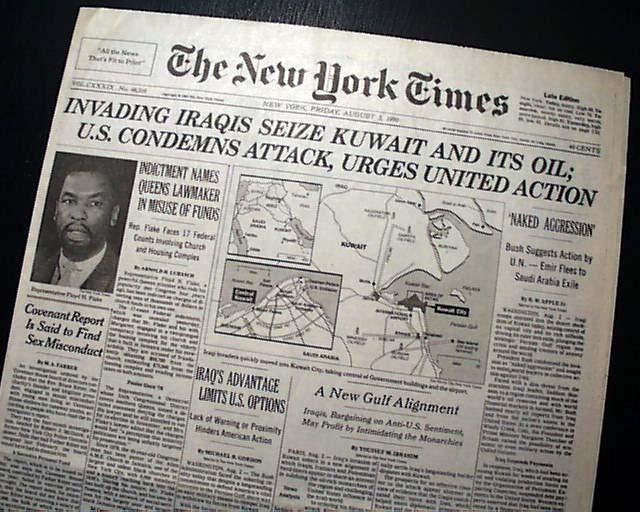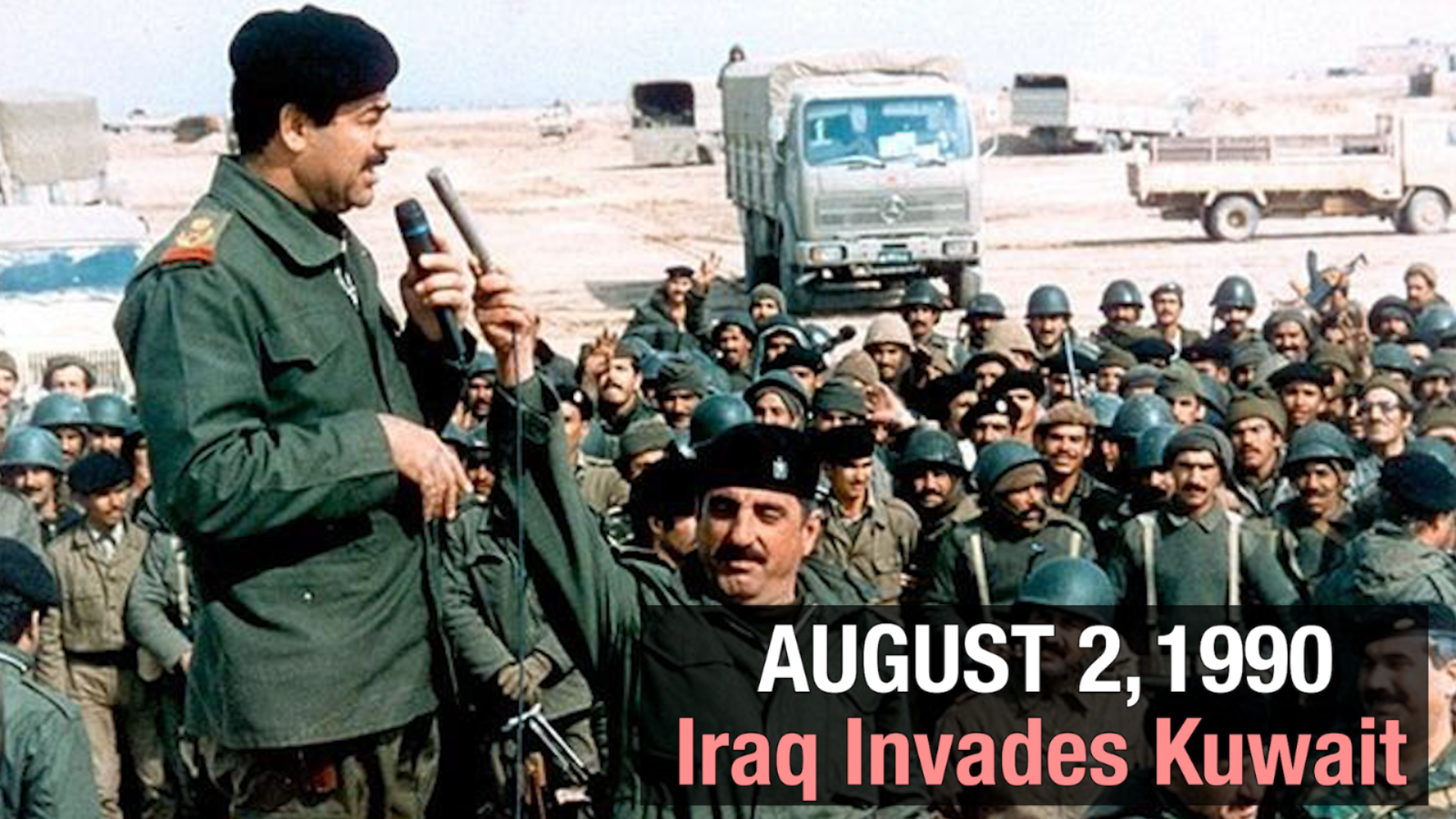



On August 2, 1990, at about 2 a.m. local time, Iraqi forces invade Kuwait, Iraq’s tiny, oil-rich neighbor. Kuwait’s defense forces were rapidly overwhelmed, and those that were not destroyed retreated to Saudi Arabia. The emir of Kuwait, his family, and other government leaders fled to Saudi Arabia, and within hours Kuwait City had been captured and the Iraqis had established a provincial government. By annexing Kuwait, Iraq gained control of 20 percent of the world’s oil reserves and, for the first time, a substantial coastline on the Persian Gulf. The same day, the United Nations Security Council unanimously denounced the invasion and demanded Iraq’s immediate withdrawal from Kuwait. On August 6, the Security Council imposed a worldwide ban on trade with Iraq.
On August 9, Operation Desert Shield, the American defense of Saudi Arabia, began as U.S. forces raced to the Persian Gulf. Iraqi dictator Saddam Hussein, meanwhile, built up his occupying army in Kuwait to about 300,000 troops. On November 29, the U.N. Security Council passed a resolution authorizing the use of force against Iraq if it failed to withdraw by January 15, 1991. Hussein refused to withdraw his forces from Kuwait, which he had established as a province of Iraq, and some 700,000 allied troops, primarily American, gathered in the Middle East to enforce the deadline.
At 4:30 p.m. EST on January 16, 1991, Operation Desert Storm, the massive U.S.-led offensive against Iraq, began as the first fighter aircraft were launched from Saudi Arabia and off U.S. and British aircraft carriers in the Persian Gulf. All evening, aircraft from the U.S.-led military coalition pounded targets in and around Baghdad as the world watched the events transpire on television footage transmitted live via satellite from Iraq. Operation Desert Storm was conducted by an international coalition under the supreme command of U.S. General Norman Schwarzkopf and featured forces from 32 nations, including Britain, Egypt, France, Saudi Arabia and Kuwait.
During the next six weeks, the allied force engaged in an intensive air war against Iraq’s military and civil infrastructure and encountered little effective resistance from the Iraqi air force or air defenses. Iraqi ground forces were helpless during this stage of the war, and Hussein’s only significant retaliatory measure was the launching of SCUD missile attacks against Israel and Saudi Arabia. Saddam hoped that the missile attacks would provoke Israel to enter the conflict, thus dissolving Arab support of the war. At the request of the United States, however, Israel remained out of the war.
On February 24, a massive coalition ground offensive began, and Iraq’s outdated and poorly supplied armed forces were rapidly overwhelmed. By the end of the day, the Iraqi army had effectively folded, 10,000 of its troops were held as prisoners, and a U.S. air base had been established deep inside Iraq. After less than four days, Kuwait was liberated, and the majority of Iraq’s armed forces had either surrendered, retreated to Iraq, or been destroyed.
On February 28, U.S. President George Bush declared a cease-fire, and on April 3 the U.N. Security Council passed Resolution 687, specifying conditions for a formal end to the conflict. According to the resolution, Bush’s cease-fire would become official, some sanctions would be lifted, but the ban on Iraqi oil sales would continue until Iraq destroyed its weapons of mass destruction under U.N. supervision. On April 6, Iraq accepted the resolution, and on April 11 the Security Council declared it in effect. During the next decade, Saddam Hussein frequently violated the terms of the peace agreement, prompting further allied air strikes and continuing U.N. sanctions.
In the Persian Gulf War, 148 American soldiers were killed and 457 wounded. The other allied nations suffered about 100 deaths combined during Operation Desert Storm. There are no official figures for the number of Iraqi casualties, but it is believed that at least 25,000 soldiers were killed and more than 75,000 were wounded, making it one of the most one-sided military conflicts in history. It is estimated that 100,000 Iraqi civilians died from wounds or from lack of adequate water, food, and medical supplies directly attributable to the Persian Gulf War. In the ensuing years, more than one million Iraqi civilians have died as a result of the subsequent U.N. sanctions.
It is my sincere desire to provide readers of this site with the best unbiased information available, and a forum where it can be discussed openly, as our Founders intended. But it is not easy nor inexpensive to do so, especially when those who wish to prevent us from making the truth known, attack us without mercy on all fronts on a daily basis. So each time you visit the site, I would ask that you consider the value that you receive and have received from The Burning Platform and the community of which you are a vital part. I can't do it all alone, and I need your help and support to keep it alive. Please consider contributing an amount commensurate to the value that you receive from this site and community, or even by becoming a sustaining supporter through periodic contributions. [Burning Platform LLC - PO Box 1520 Kulpsville, PA 19443] or Paypal
-----------------------------------------------------
To donate via Stripe, click here.
-----------------------------------------------------
Use promo code ILMF2, and save up to 66% on all MyPillow purchases. (The Burning Platform benefits when you use this promo code.)





Can’t Really remember…was cnn a thing before This? Or MADE for it? Possibly, waiting in the wings? Like the Clot/Sterility shots?
Dessert (4 the M.I.C.) Storm. AND cnn.
Were anderson and geraldo out of the closet yet? Or in it together?
Inquiring minds wanna know!
And the next day I was on a C5 headed to Riyadh Saudi Arabia.
April Glaspie gave Saddam the go-ahead.
My favorite unspoken part of the story is how the .gov allowed Saddam to sell oil to Europe out the back door while we’re flying F-16’s around in a “no-fly zone”!
Tell me whos playing the sucker?!?…
The Patriot Project Manager(PM), COL Bruce Garnett, walked into my office and asked me what I knew about Iraq. Having nothing to say except for the Stark incident of the recent past he directed me to get an info paper together and the leadership would meet at 1700 that night. I called the Patriot Dept of the Army Systems Coordinator at SARDA in the PNT and got the paper together. We met and the PM really looked over the horizon and gave us direction that got us going long before everyone else. We did not stop until after COL Garnett retired the next May when he was a non-select for BG……….a major crime in our book.
That was one hell of a year with no rules and results expected daily and sometimes hourly.